Say goodbye to your worries of clutter and disarray—welcome an orderly home with our ultimate decluttering checklist.
We cover every room in the house, and we put everything inside a free printable declutter checklist.
With these decluttering tips at hand, you can look forward to creating a warm and inviting atmosphere that you and your family can enjoy every day of the week.
Why declutter? The importance of decluttering
Decluttering isn’t just about having a lovely-looking space. More importantly, it can lead to improved mental and physical health as well as increased productivity.
Reason 1. Mental health benefits
Clutter can be a major source of stress and anxiety, causing people to feel overwhelmed, embarrassed, or guilty.
Luckily there is an easy solution: decluttering! This practice brings numerous advantages—like reducing tension levels in your life, aiding sleep quality, and helping you concentrate better on tasks at hand.
Reason 2. Increased productivity
Getting rid of clutter is essential for productivity. Messiness and disorganization can be harmful to one’s focus, causing delays and a lack of efficiency.
In fact, one study found that people who are conscientious tend to make more mistakes when they’re in a messy environment compared to when they’re in a tidy one.
Reason 3. Enhanced aesthetics
Decluttering helps your space look better in several ways. First and foremost, it reduces visual noise and creates a sense of order.
For example, decluttering gets rid of excess items like paper clutter and other piles of mess.
When you remove excess items and unnecessary clutter, there’s less distraction, and your eyes can focus on the key elements of the space. This can make the room feel more peaceful and aesthetically pleasing.
How to start decluttering
The process of removing clutter can seem overwhelming, but the key is breaking it up into smaller tasks by tackling one room at a time.
Setting goals and having some sort of routine will help you stay on track as well.
Here are the 3 simple steps that we recommend you use as you put the decluttering checklist into action:
Step 1. Execute a room-by-room approach
Start your decluttering mission by taking on the messiest room first and continuing through each area of your house. Doing it this way will help you concentrate and not get overwhelmed.
Remember, achieving a clutter-free state won’t happen overnight. Start decluttering one room at a time, and that will help you not lose motivation.
Step 2. Set achievable goals
Split tasks into small pieces you can handle and take breaks when necessary. Don’t try to tackle this declutter checklist all in one go.
A wise person once said: “It’s the person that moves a mountain who begins by carrying away little stones.”
Make sure your goals are reasonable so they don’t seem intimidating.
Step 3. Create a schedule
Stick with an organized decluttering plan. Dedicate at least 3 or 4 hours each week and design the timetable according to what you need.
Be sure to set yourself reminders so that these sessions remain top of mind.
Step 4. Prepare essential decluttering tools and supplies in advance
To battle effectively against mess, gather the right tools.
Sorting containers, labels, cardboard boxes for unwanted items, cleaning materials, as well as storage solutions, are all essential items to have during the decluttering process.
Break free from paper clutter ✨
Use Shoeboxed’s app and scanning service to scan receipts and organize your wallet and office. 30-day full money-back guarantee!
Get Started TodayRoom-specific decluttering checklists
Make your decluttering mission efficient by using these room-specific checklists for the kitchen, bedroom, living room, and beyond.
Kitchen decluttering checklist
The kitchen can easily become an overwhelmed mess—use this list to help put it in order.
Clear off countertops: Remove all items from the countertops and only keep essential items that you use regularly, such as a coffee maker or toaster.
Sort through cabinets and drawers: Empty out one cabinet or drawer at a time and go through its contents. Discard any expired food, broken, or unused utensils, and items you no longer need or use.
Organize the pantry: Remove all items from the pantry shelves and assess their condition and expiration dates. Toss expired items and donate non-perishable food that you won’t consume. Categorize similar items and arrange them neatly on the shelves.
Clean out the fridge: Take everything out of the refrigerator and check for expired or spoiled food. Wipe down the shelves and drawers, and organize the remaining items by grouping similar foods together.
Review and streamline cookware: Assess your collection of pots, pans, and bakeware. Get rid of any damaged or rarely used items. Keep the essentials and consider donating or selling the rest.
Tackle the spice rack: Check the expiration dates on your spices and herbs. Discard any that are past their prime or have lost their flavor. Consider using clear spice jars or organizers to keep them organized and easily visible.
Clear out the junk drawer: Empty the infamous junk drawer and decide what items are truly necessary. Dispose of any items that are broken, outdated, or no longer serve a purpose.
Streamline dishware and glassware: Evaluate your collection of dishes, glasses, and mugs. Keep enough for your regular needs and donate or discard any chipped, mismatched, or excessive items.
Declutter small appliances: Assess your small kitchen appliances, such as blenders, mixers, or slow cookers. Keep the ones you use regularly, and consider donating or selling the ones that are gathering dust.
Organize cleaning supplies: Sort through your cleaning supplies and get rid of expired or duplicate products. Keep them in a designated area, such as under the sink, and use storage bins or caddies to keep them organized.

Bedroom decluttering checklist
Your sleeping space should be an oasis, with minimal mess and disarray. Here’s your declutter checklist to help you methodically get rid of bedroom clutter:
Clear out the closet: Empty your entire closet and sort through each item. Donate or sell clothes, shoes, and accessories that you no longer wear, don’t fit, or are out of style. Organize the remaining items by category (e.g., tops, pants, dresses) and return them to the closet in an orderly manner.
Assess dresser drawers: Empty one drawer at a time and evaluate its contents. Remove any items that are stained, damaged, or no longer needed. Fold and organize clothing neatly, using dividers or organizers to separate different clothing types.
Streamline your shoe collection: Review your shoe collection and donate or discard any pairs that are uncomfortable, worn out, or no longer your style. Keep the shoes you wear frequently and organize them using shoe boxes or storage solutions.
Evaluate bedside table: Clear off your bedside table and reassess the items you keep there. Remove any clutter or items that don’t belong, such as empty cups or unnecessary electronics. Keep essential items like a lamp, alarm clock, or book, and consider using drawer dividers to keep smaller items organized.
Declutter the surfaces: Remove any unnecessary items from dressers, shelves, and other surfaces. Keep only meaningful or decorative items and find designated places for them. Consider using storage boxes or baskets to corral smaller items and maintain a tidy appearance.
Clear out the under-bed space: Take a look under your bed and clear out any items stored there. Decide whether you still need those items, and if not, consider donating or finding alternative storage solutions. If you use the under-bed space for storage, use storage containers or organizers to keep items organized and easily accessible.
Review books and magazines: Sort through your bookshelf or stack of magazines. Donate or sell books you’ve already read and don’t plan to reread. Keep only the books or magazines that hold sentimental value or are still of interest to you.
Organize jewelry and accessories: Untangle and organize your jewelry, such as necklaces, bracelets, and diamond stud earrings. Consider using jewelry organizers or trays to keep them separated and easily accessible. Sort through accessories like belts, scarves, or hats and donate or discard any items that are no longer worn or needed.
Evaluate furniture and decor: Take a critical look at your bedroom furniture and decor. Remove any items that are broken, damaged, or no longer align with your style. Consider rearranging furniture to create a more functional and visually pleasing layout.
Maintain a clutter-free zone: Establish a clutter-free zone in your bedroom, such as a designated chair or area where you won’t allow items to accumulate. Regularly check and remove any items that find their way into this zone.

Living room decluttering checklist
Decluttering your living room can be a great way to free up some much-needed space for gatherings or family time. Here’s a decluttering list to help you take back your shared space.
Clear surfaces: Remove any items that don’t belong on coffee tables, side tables, or entertainment centers. Keep only essential items or decorations that you truly love, and find a designated place for each item.
Organize media and electronics: Sort through your collection of DVDs, CDs, or video games. Donate or sell any media that you no longer use or enjoy. Consider using storage solutions like media cabinets or shelves to keep them organized. Untangle and manage cords and cables for electronic devices to reduce visual clutter.
Assess bookshelves: Review your book collection and donate or sell books that you’ve already read or no longer want to keep. Arrange the remaining books by category or in a visually pleasing manner. Consider using bookends or storage boxes to keep smaller items organized.
Streamline decorations: Evaluate your decorative items, such as figurines, vases, or sculptures. Keep the ones that hold sentimental value or enhance the aesthetics of the room. Remove any decorations that feel excessive or cluttered. Display items strategically, considering balance and visual appeal.
Tidy up the entertainment center: Clear out any unnecessary items from your entertainment center, such as remote controls, gaming accessories, or outdated electronics. Use cable management solutions to keep cords organized and minimize visual distractions.
Manage magazines and newspapers: Sort through stacks of magazines or newspapers and recycle or donate ones you no longer need or plan to read. Consider using a paper filing system such as magazine holders or baskets to keep current reading materials organized.
Declutter shelves and display cases: Evaluate the items on your shelves or in display cases. Remove any objects that no longer serve a purpose or hold meaning for you. Keep the display minimal and curated, focusing on items that bring you joy or have sentimental value.
Evaluate furniture placement: Assess the arrangement of your furniture to ensure it promotes a sense of spaciousness and functionality. Rearrange or remove pieces that obstruct traffic flow or create a cluttered appearance.
Control remote control clutter: Consider using a remote control organizer or caddy to keep all remote controls in one place. This helps prevent them from getting lost or cluttering up the living room.
Implement storage solutions: Utilize storage containers, such as ottomans with hidden compartments or shelving units with baskets, to store and organize items like custom blankets, pillows, or board games.

Garage decluttering checklist
Transform your garage into an organized and functional space by starting here.
Sort items into categories: Start by categorizing the items in your garage. Create groups for tools, sports equipment, gardening supplies, automotive supplies, seasonal decorations, and other common items found in a garage.
Declutter each category: Go through each category one by one and assess each item. Dispose of broken or damaged items that can’t be repaired. Donate or sell items that are in good condition but are no longer needed or used.
Create zones: Designate specific areas or zones in your garage for different purposes. Create a zone for tools, a zone for sports equipment, a zone for gardening supplies, and so on. This will help you keep similar items together and make them easier to find when needed.
Evaluate large items: Take a look at larger items such as bicycles, lawnmowers, or unused furniture. Determine if they are still functional and serve a purpose. If not, consider selling, donating, or properly disposing of them.
Utilize wall space: Install shelving units, pegboards, or hooks on the walls to maximize vertical storage. This will help you keep the floor clear and provide ample space for organizing items like tools, gardening equipment, or sports gear.
-
Organize small items: Use clear storage bins, labeled
hinged-lid containers or drawers to store smaller items like nails, screws, bolts, and other hardware. This will make it easier to find and access these items when needed.
Utilize overhead space: If you have high ceilings in your garage, consider installing overhead storage racks or platforms. This is a great way to store items that are used less frequently or are seasonal, such as holiday decorations or camping gear.
Dispose of hazardous materials properly: Check your garage for any hazardous materials such as old paint cans, chemicals, or expired fire extinguishers. Ensure they are disposed of safely according to local regulations.
Organize outdoor gear: If you store outdoor gear like bikes, kayaks, or camping equipment in the garage, create a designated area for them. Install bike racks or hooks to hang bicycles, and use wall-mounted racks or shelves for other outdoor equipment.

Home office decluttering checklist
Follow this list for a more productive workspace.
Clear off the desk: Remove all items from the desk surface and create a clean and minimalist workspace.
Organize paperwork: Sort through your paper clutter. Scan receipts and other documents, or ship all your boxes of important papers to Shoeboxed to scan them up for you!
Evaluate office supplies: Go through your office supplies and get rid of any items that are damaged or no longer usable.
Declutter digital files: Organize and declutter your email and computer files.
Review books and reference materials: Assess your bookshelf or reference materials.
Manage cables and cords: Tidy up the cables and cords around your desk area.
Clear out outdated electronics: Dispose of any outdated or broken electronics cluttering your office space.
Streamline stationery and notebooks: Sort through stationery and notebooks.
Create a designated storage system: Establish a storage system for business cards, office supplies, files, and other essentials.

How can Shoeboxed help you declutter?
Shoeboxed is a receipt and document scanning service that can help you declutter your home office or your piles of paper that you need to sort through!
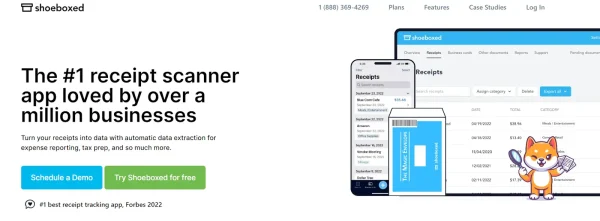
Simply sign up to a Magic Envelope plan and Shoeboxed will send you a prepaid envelope that you can use to ship all your papers and receipts to Shoeboxed's scanning facility in Durham, NC!
Once your receipts and documents reach the Shoeboxed facility, they’ll be digitized, human-verified, and tax-categorized in your account.
Have your own filing system?
Shoeboxed will even put your receipts under custom categories. Just separate your receipts with a paper clip and a note explaining how you want them organized!
Break free from paper clutter ✨
Use Shoeboxed’s Magic Envelope to ship off your receipts and get them back as scanned data in a private, secure cloud-based account. 📁 30-day full money-back guarantee!
Get Started TodayWhat else can Shoeboxed do?
Shoeboxed has been voted as the best receipt scanner app for tax season by Hubspot and given the Trusted Vendor and Quality Choice awards by Crozdesk.
A quick overview of Shoeboxed's award-winning features:
a. Mobile app and web dashboard
Shoeboxed’s mobile app lets you snap photos of paper receipts and upload them to your account right from your phone.
Shoeboxed also has a user-friendly web dashboard to upload receipts or documents from your desktop.
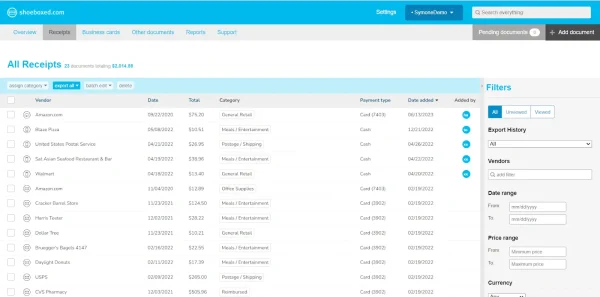
b. Gmail receipt sync feature for capturing e-receipts
Importing e-receipts to your Shoeboxed account is as easy as syncing your Gmail with Shoeboxed, using Shoeboxed's special Gmail Receipt Sync feature.
Shoeboxed’s Gmail Receipt Sync grabs all receipt emails and sends them to your account for automatic processing! These receipts are then labeled as Sent to Shoeboxed in your Gmail inbox.
In short, Shoeboxed pulls the receipt data from your email, including the vendor, purchase date, currency, total, and payment type, and organizes it in your account.
Your purchases will even come with images of the receipts attached!
c. Expense reports
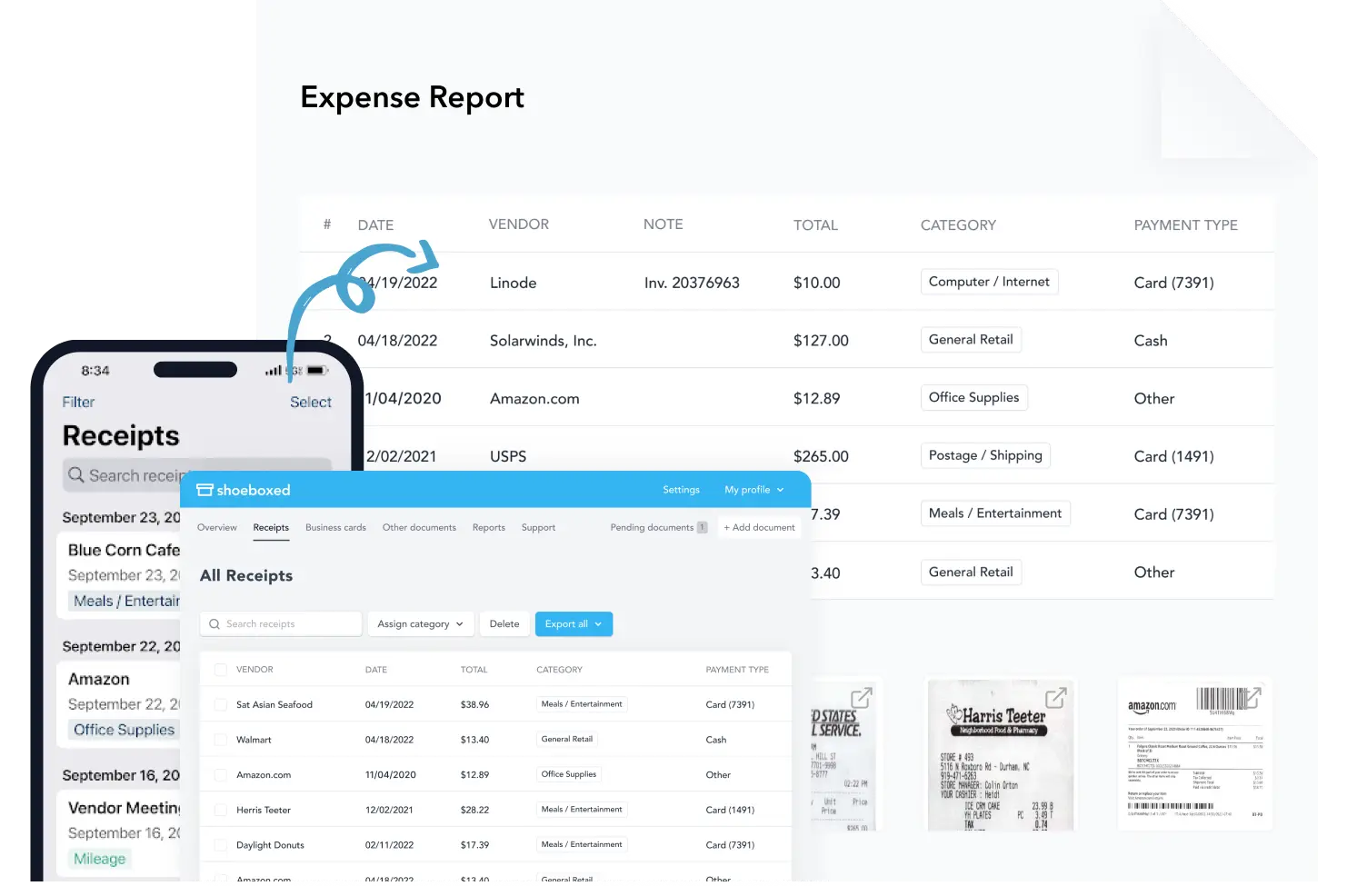
Expense reports let you view all of your expenses in one cohesive document. They also make it simple to share your purchases with your accountant.
Shoeboxed makes it easy to export your yearly expenses into a detailed report. All expenses come with receipts attached.
You can also choose certain types of receipts to include in your expense report. Just select the receipts you want to export and click “export selected.”
d. Search and filter

Call up any receipt or warranty in seconds with advanced search features.
Filter receipts based on vendors, date, price, currency, categories, payment type, and more.
e. Accounting software integrations
Export expenses to your accounting software in just a click.
Shoeboxed integrates with 12+ apps to automate the tedious tasks of life, including QuickBooks, Xero, and Wave Accounting.
f. Unlimited number of free sub-users
Add an unlimited number of free sub-users to your account, such as family members, employees, accountants, and tax professionals.
g. Mileage tracker for logging business miles
After you sign up for Shoeboxed, you can start tracking miles in seconds:
Open the Shoeboxed app.
Tap the “Mileage” icon.
Click the “Start Mileage Tracking” button.
And drive!
Whenever you start a trip, Shoeboxed tracks your location and miles and saves your route as you drive.

As you make stops at stores and customer locations, you can drop pins to make tracking more precise.
At the end of a drive, you’ll click the “End Mileage Tracking” button to create a summary of your trip. Each summary will include the date, editable mileage and trip name, and your tax deductible and rate info.
Click “Done” to generate a receipt for your drive and get a photo of your route on the map. Shoeboxed will automatically categorize your trip under the mileage category in your account.
h. The Magic Envelope
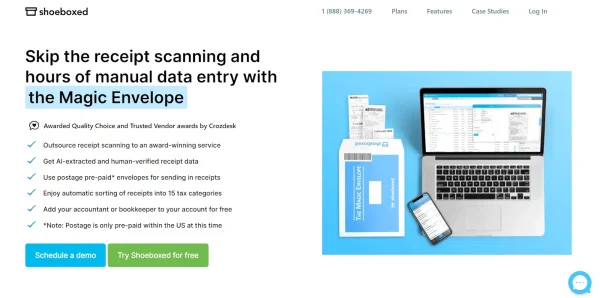
Outsource your receipt scanning with the Magic Envelope!
The Magic Envelope service is one of Shoeboxed's most popular features, particularly for businesses, as it lets users outsource receipt management.
Simply stuff your receipts into Shoeboxed's postage-prepaid envelopes and outsource receipt scanning to the pros.
Shoeboxed is the only receipt scanner app that will handle both your paper receipts and your digital receipts—saving customers up to 9.2 hours per week from manual data entry!
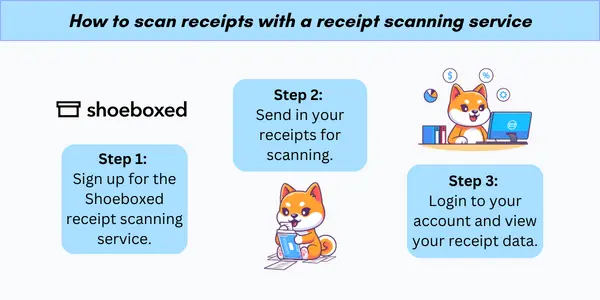
Stop doing manual data entry 🛑
Outsource receipt scanning to Shoeboxed’s scanning service and free up your time for good. 30-day full money-back guarantee! ✨
Get Started TodayTips for efficient and sustainable decluttering
Tip 1. Establish routines
Staying organized in your home requires forming a routine. To make sure clutter doesn’t build up, assign moments throughout the day, week, or month to organize certain places.
Home accounting jobs and similar virtual jobs have different demands, so it’s essential to find a routine that works for you.
Tip 2. Make it a habit to recycle and donate
Consider giving away clothing, furniture, or other products that are no longer needed to charities within the community. Anything you are unable to donate can be placed in the recycling bin, which also helps lower overall wastefulness.
Tip 3. Practice mindful consumption
Mindful buying (dare I say “minimal”?) should be your default if you aim to have a neat home.
By being mindful of the items that are making their way inside the house, you can decrease clutter levels and make sure that the place stays tidy.
How do I handle sentimental and challenging items?
Decluttering can be hard as it involves letting go of things with emotional and personal value. To help in this process, here are some decluttering tips for how to handle sentimental items.
1. Set boundaries
Designate a space that can be used for storing sentimental possessions. Once that space is used up, it’s time to say goodbye to the things that don’t fit.
2. Digitize memories
Establish the habit of scanning photos, documents, etc., then storing them on the cloud for quick access. This way, you can free up some space in your house while still being able to retain all those cherished moments forever.
3. Learn to let it go
Letting go of beloved items can be difficult, but releasing unneeded clutter allows for more opportunity and space for new experiences!
Frequently asked questions
Why is decluttering your home important?
Decluttering is essential for improved mental and physical health, increased productivity, and enhanced aesthetics. Clutter can cause stress and anxiety, while decluttering reduces tension levels and improves focus. It has been found that people make more mistakes in messy environments. Removing excess items creates a visually pleasing and peaceful space. Overall, decluttering promotes well-being, efficiency, and a more aesthetically pleasing environment.
What is the rule of 5 in decluttering?
The rule of 5 in decluttering is about selecting 5 items per room and disposing of them.
What is the 20/20 rule for decluttering?
Decluttering can be a challenge, but the 20/20 rule makes it simpler! You just need to ask: Will I find an alternative for less than $20 and within twenty minutes? If you answer yes, then it is time for that thing to go.
In closing
Tackling clutter can be an intimidating endeavor, but breaking it down into smaller tasks makes the process easier.
Use this decluttering checklist and the printable checklist version to help get your home decluttered so you can enjoy your downtime with more serenity and less stress.
Tomoko Matsuoka is managing editor for Shoeboxed, MailMate, and other online resource libraries. She covers small business tips, organization hacks, and productivity tools and software.
About Shoeboxed!
Shoeboxed is a receipt scanning service with receipt management software that supports multiple methods for receipt capture: send, scan, upload, forward, and more!
You can stuff your receipts into one of our Magic Envelopes (prepaid postage within the US). Use our receipt tracker + receipt scanner app (iPhone, iPad and Android) to snap a picture while on the go. Auto-import receipts from Gmail. Or forward a receipt to your designated Shoeboxed email address.
Turn your receipts into data and deductibles with our expense reports that include IRS-accepted receipt images.
Join over 1 million businesses scanning & organizing receipts, creating expense reports and more—with Shoeboxed.
Try Shoeboxed today!



